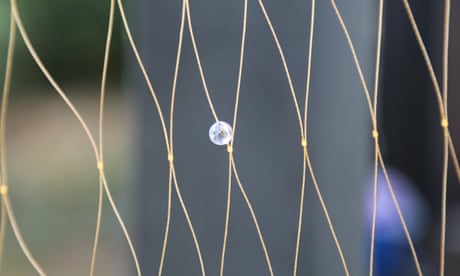- by foxnews
- 04 Mar 2025
Plastic beads could make nets more visible to cetaceans, scientists say
Plastic beads could make nets more visible to cetaceans, scientists say
- by theguardian
- 30 Dec 2021
- in news

Simple plastic beads could save the lives of some of the thousands of porpoises and other cetaceans that get caught in fishing nets each year, scientists say.
Harbour porpoises use echolocation to find their prey and for orientation. However, their acoustic signals cannot pick up the mesh of a gillnet, and as a result they often become trapped.
Stepputtis and his colleagues have come up with an elegant new concept to make the nets visible to aquatic mammals using echolocation. They fit the nets with transparent beads made of acrylic glass. The material has approximately the same density as water, so it adds hardly any extra weight to the fishing gear. But when it is hit by biosonar, the polymer sends back an extraordinarily strong echo, warning animals that there is something ahead.
The first trials of the technology, conducted off the Danish island of Funen in the western Baltic, have shown promise. Harbour porpoises hunting in the area kept clear of a bead-equipped net. Researchers recorded the acoustic signals of the animals, which should give more insight into their exact behavioural responses.
The method may have some limitations, though. The scientists conducted another series of tests in the Black Sea, where a turbot fishery produces a very large bycatch of harbour porpoises. Sometimes more than a dozen are killed in a day, says Stepputtis. The researchers carried out 10 hauls each with a standard gillnet and a net fitted with the beads. Five porpoises were killed in the standard nets and two in the modified nets.
Stepputtis suggests the entangled animals might have been asleep. Dormant porpoises keep on swimming but only occasionally switch on their biosonar. For this reason, Stepputtis and colleagues are also using a new acoustic alerting device that emits synthetic porpoise warning signals. In field trials, the device reduced bycatch by almost 80%.
The polymer beads can be adapted for optimal resonance at the frequencies that different species use. Stepputtis says it should be able to be adapted for all species that use echolocation, including the Amazon river dolphin. Combining the two concepts has the potential to save thousands of animals, the scientists say.
Every year millions of dolphins, turtles, seabirds and other marine fauna die in various kinds of fishing gears. Experts estimate the total annual toll for whale species amounts to about 300,000.
Bycatch poses a serious threat to the survival of various species. Illegal gillnet fishing in the Gulf of California has pushed the vaquita to the brink of extinction, while in the north-west Atlantic, critically endangered right whales get entangled in the lines of lobster pots.
- by foxnews
- descember 09, 2016
Bus travel sees 'steady growth' as flyers seek alternative transportation
People who ride on airplanes might rely on alternative transportation for a number of reasons. A CEO of a bus travel company shares insights with Fox News Digital.
read more


